
August 2019
Today, I’m going to address a publication known as the Letter to a CES director, or The CES Letter, My search for Answers to my Mormon Doubts. Hereafter, I will simply call it “The CES letter,” “the letter,” or “the book.” Additionally, I may refer to the author of the CES Letter as simply “The author”. It is with some hesitation that I address this topic as I know that it is near and dear to some people’s hearts. Like politics, it has become a polarizing document. I hope that no one who sees, hears, or reads my comments believes I have anything but love and respect for those who struggle with issues of remaining in the Church or leaving. If I try to interject some humor from time to time, which my wife has repeatedly told me not to do, please know that it isn’t directed at any individual as I know these things are real struggles.

Of course, the best answer for finding the truth is found in the Book of Mormon, Moroni, chapter 10 verse 5 which says, and by the power of the Holy Ghost ye may know the truth of all things. Obtaining an answer from God is the ultimate way to discern truth.
So, why talk about the CES letter at all? Why not just direct people to pray and read the scriptures?

This is also answered in the scriptures where the Lord says in D&C 109: 7 “And as all have not faith, seek ye diligently and teach one another words of wisdom; yea, seek ye out of the best books words of wisdom, seek learning even by study and also by faith.”
We all have times when for whatever reason our faith waivers. Sometimes it is sin, sometimes it is trials, sometimes it is pride, and sometimes it is prosperity. There are as many different reasons as there are different people. During those times, we are vulnerable to other influences, and just like in Alma 32 where a seed of faith can be planted and grown, a seed of doubt can likewise be planted and grown.
The CES Letter is an attempt to create an alternate narrative for the truth claims of The Church of Jesus Christ of Latter-day Saints.
I watched the early creation of the CES Letter in 2013 as the author scoured the internet crowdsourcing other like-minded people to contribute questions that they would like to see answered. It has been published online and in book fashion and translated into Spanish, Portuguese, Swedish, Japanese, German, and they are working on Finish and other languages.
It has become a proselyting tool in attempts to draw people away from the Church and it has been very successful.
Some in the former Latter-day Saint community have posted pictures of writing the link to the document into Book of Mormons in Churches, Marriott Hotels, in Hymn books, and other locations. In April 2014 it was spam emailed to hundreds of students at the LDS business college in Salt Lake City.[1]



It even showed up on Spiderman in a Marvel comic.

Pass-along cards have been created to spread the news.

Many have gone to great lengths to spread the gospel of the CES letter. While it isn’t the first publication to take a long list of old criticisms of the Church and present is as if it is new, it has become the one with the most unified backing behind it. I hear from people on a regular basis that they have been asked to read this book from their disaffected spouse, child or friend. I must say that disaffected members seem to be much more excited about passing out this book, then some faithful members seem to be in passing out copies of the Book of Mormon.
The CES Letter is 13 chapters long with a conclusion at the end. I count 77 official listed questions in the letter although some branch off into other side questions and some of them are repeats.
The book challenges the reader to have answers to the long list of questions right now. But most normal people won’t have a list of answers at their fingertips that counter the list of claims. Each one of the questions requires research and time that most people simply don’t have.
This is one talk that will last less than one hour. I can’t possibly cover the entire subject so I would like to refer you to other resources on the CES Letter list on this PowerPoint slide.

Much ink has been spent on replying to this book. I reread all of those responses in preparing the talk. I also reread the response given by the author of the CES letter regarding the criticisms of his letter.
So, what does the Letter itself say? What is it that people read that brings them out of the Church? And to get to the heart of the matter, is the CES Letter proof the Church is false, or is it just propaganda?

The theme of the Book is that the Church has lied to you about its history, and about Joseph Smith as a translator and prophet, so there is no way it can be true.

It adds on to this that people who have looked at these issues and given answers for them, such as FairMormon, The Interpreter, Book of Mormon Central, and many individuals, are just unofficial apologists so their opinions can’t be trusted.
As I have said, I can’t cover the contents of the entire book in less than one hour. So I will only focus on Chapter 1. As I cover each claim, stated as a question, I will be quoting directly from the book and calling each claim point 1, point 2, and so on.
So, here we go.

The first three points the letter makes are all interrelated. They all center around the translation process of Joseph Smith and the Book of Mormon.
- Why are King James Version errors in the Book of Mormon?
- Why are italicized words in the Book of Mormon?
- Why doesn’t the Book of Mormon follow the Joseph Smith Translation?
While reading the entire book, I noticed that the translation concerns came up repeatedly. So, this seems to be a really big deal for the author.
The first claim – using the words from the CES Letter is– What are 1769 King James Version edition errors doing in the Book of Mormon? A purported ancient text? Errors which are unique to the 1769 edition that Joseph Smith owned?”[2]
That’s all it says. There is no support, explanation, or examples given in the book for this assertion.
Luckily, there is a footnote that links you back to the author’s Website.
The impression I get from reading the linked-to webpage, is that the Book of Mormon must exactly match the earliest known documents. The words are directly from God, so if they deviate from what they should be, it proves Joseph Smith isn’t really a true prophet.
The problem with this position is that translation between languages doesn’t work that way.
Also on that linked-to page I found a chart of what the Book of Mormon gets “wrong.”[3]

The chart helpfully gives a Quote “Correct translation” column.

As I look at the first 4 items in the chart, two of them have incorrect scriptural references – probably typos – and one of them incorrectly quotes the Book of Mormon. It then states that the translation is identical to the King James Version, which it is not, and gives us the alleged correct translation which ironically is exactly what the Book of Mormon says.
Given this is the first argument, we aren’t off to a very good start.
In spite of that, I would like to test that first claim anyway using one of the other examples. This comes from Isaiah 2:16 and 2 Nephi 12:16.

The alleged mistake in the Book of Mormon verse is the word “Pictures.” The so-called Correct translation should be image, or ships, or craft. So, my first question is which ONE? Which one is the correct one? Forging ahead I go to www.biblestudytools.com, an excellent resource by the way, I looked at several versions of the Bible I get
American Standard “Imagery”
Bible in Basic English “fair boats”
Darby “Works of Art”
English Standard “Beautiful craft”
Young’s Literal “all desirable pictures”
There seems to be disagreement. I think we can agree that pictures, Imagery and works of art are pretty much the same concept. I think it is an interesting variation talking about beautiful boats, but I can see that being pretty pictures as well.
I will freely admit that I am not a Bible scholar, but pictures seems to fit as an acceptable translation. But this doesn’t fit the CES Letter “correct translation” theory.

These differences in translation are often referred to as variations.
Who is to say which variation is correct, unless you have a direct pipeline to God?
And that seems to be exactly the argument that is being made. If Joseph Smith is a prophet, he DID have a direct pipeline to God and therefore, he would have used the translation I think is correct. My response is that while translation variations are interesting, we don’t have enough information to use this as evidence that Joseph Smith was or was not a prophet.
This unfamiliarity with moving between languages continues in point #2.

“When King James translators were translating the KJV Bible between 1604 and 1611, they would occasionally put in their own words into the text to make the English more readable. We know exactly what these words are because they’re italicized in the KJV Bible.”

“What are these 17th century italicized words doing in the Book of Mormon? Word for word? What does this say about the Book of Mormon being an ancient record?”[4] Let me try to explain this concept.

If I want to express the idea that I want to go for a walk in German, I would say, Ich möchte spazieren gehen.
It takes four words. But, to translate this presents some challenges.

The first challenge is the word möchte with that o with two dots over it. Not only do we not have that letter, we don’t have that word. There is no single word that translates as möchte. The closest single word would be “want”, but there is a different word for that in German “wollen” which would be conjugated as “will”, so want doesn’t really work.
The best translation into English would be “would like” which is two words.
But, our problems are not over. We can’t say, “I want walk go”, or even “I would like walk go.” That would make us sound like two-year-olds.

To make it work in English, you change the 4-word sentence from German and translate it into an 8 word sentence, “I would like to go for a walk.”
In the King James Version of the Bible, they simply took those extra 4 words and italicized them to let you know that those words are there to help it read smoothly in English.

So, to answer the original question. What are these 17th century italicized words doing in the Book of Mormon? Word for word?
Because it is English. It shouldn’t surprise us that the Book of Mormon includes these words too, since they are necessary for the translation to be readable.
What does this say about the Book of Mormon being an ancient record?
Nothing at all. It’s a translation.
This brings us to point 3.

“The Book of Mormon includes mistranslated biblical passages that were later changed in Joseph Smith’s translation of the Bible. These Book of Mormon verses should match the inspired JST version instead of the incorrect KJV version that Joseph later fixed.”[5]
What is the Joseph Smith Translation? Is it a more accurate translation of ancient records as the CES Letter seems to say?

In the 1997 Ensign church magazine, it says:
“The Prophet did not “translate” the Bible in the traditional sense of the word—that is, go back to the earliest Hebrew and Greek manuscripts to make a new rendering into English. Rather, he went through the biblical text of the King James Version and made inspired corrections, revisions, and additions to the biblical text.”[6]
From History Topics on the Church website we learn “… Joseph Smith also made many smaller changes that improved grammar, modernized language, corrected points of doctrine, or alleviated inconsistencies. As he worked on these changes, he appears in many instances to have consulted respected commentaries by biblical scholars, studying them out in his mind as a part of the revelatory process.”[7]
D&C 1:24 Behold, I am God and have spoken it; these commandments are of me, and were given unto my servants in their weakness, after the manner of their language, that they might come to understanding.
In D&C 128:18 referring to the Biblical text in Malachi, Joseph Smith says: “I might have rendered a plainer translation to this, but it is sufficiently plain to suit my purpose as it stands.”
The entire premise of the question appears to be flawed. Despite that, I am going to discuss the evidence the CES Letter uses to make its point.
In the CES letter, the author shows 3 Nephi 13:25-27, Matthew 6:25-27 and Matthew 6:25-27 from the Joseph Smith Translation.

Then he makes the following claim: “Christ’s Sermon on the Mount in the Bible and the Book of Mormon are identical. But Joseph Smith later corrected the Bible. In doing so, he also contradicted the same identical Sermon on the Mount passage in the Book of Mormon.”[8]
There are two problems with this. The first problem is that the two verses are NOT identical. Let’s take a look at this. Here are the Matt 6:25-27 verses in the King James Version.

Here are the 3 Nephi 25-27 verses in the Book of Mormon. They do look identical in the CES Letter.

But, even though the author of the Letter claims they are, you can see the verses are not identical because the ellipses, the …, that comes at the beginning of verse 25.

That … means that words are missing as you can see.

Then the CES Letter argues that in the Joseph Smith Translation, Joseph Quote “contradicted the same identical Sermon on the Mount passage in the Book of Mormon”[9] As evidence he shows Matthew 6: 25-27 from the Joseph Smith Translation.

This presents the second problem. The CES Letter gives us chapter 6 verses 25-27 because that is where that passage is found in the King James Version. The fact that the verse numbers are the same in the Book of Mormon is simply a coincidence. Remember, that there was no verse numbering in the original edition of the Book of Mormon.

This same passage is also found in the Joseph Smith translation, but in verses 28-31[10], not verses 25-27. By comparing verses 25 through 27 in all three texts, he makes it appear that Joseph Smith has changed the passage in the Joseph Smith Translation, when the author is actually comparing the wrong passage. I would not have a problem if Joseph Smith had changed the passages. We can look at Jeremiah chapter 36 for an example of that. That is what Prophets do. They add to and expound on the Word of God. But, in this case, it is simply an incorrect comparison.

The next three points in the letter have to do with DNA, Anachronisms, and Archeology. In the interest of time, I’m going to refer you back to the many articles on the FairMormon Website and to Matt Roper’s discussion on anachronisms at this conference on Wednesday. But, I would like to make just a few quick points.
We know that Vikings were in America. There is native American DNA in Iceland and we have historical records, but, as of yet, we have found no Viking DNA among Native Americans. Leading geneticists who study these things say that DNA neither proves, nor disproves the Book of Mormon.
Regarding anachronisms and archaeology. Anachronisms are often artifacts of translation as translators are attempting to convey thoughts and ideas to the understanding of their contemporaries using words and items that are familiar to them. The Bible contains anachronisms such as its use of candles instead of the oil lamps that were common in ancient times. Additionally, some things appear to be anachronisms because archaeologists have not found physical evidence as yet of items that are mentioned. But that continues to change as work in the field expands.
The CES letter also complains of the lack of Book of Mormon archeology around the current Hill Cumorah area in upstate New York. Many Book of Mormon scholars have a much larger geographical idea of where the Book of Mormon peoples might have lived. This includes the great civilizations of the Americas and Mesoamerica. Certainly, we haven’t found a freeway exit sign to Zarahemla, but we have made some exciting discoveries in the old and new world alike.

This takes us to point 7: “Many Book of Mormon names and places are strikingly similar to many local names and places of the region where Joseph Smith lived.”[11]
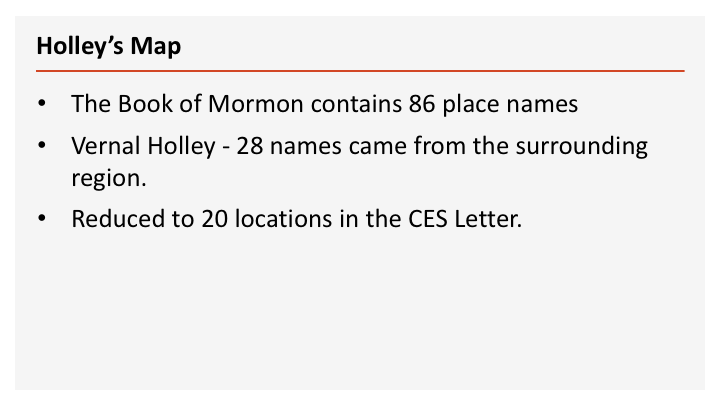
The Book of Mormon contains 345 names, 86 of which are related to geographic locations. In 1983, a man named Vernal Holley brought up the idea that Joseph Smith got the place names in the Book of Mormon from his surrounding area. He then showed 28 names on what he claims to be a Book of Mormon map.
Holley’s map was dismissed because many of the communities did not exist at the time of Joseph Smith. It appears Holley had looked at a modern map.
The Letter to a CES director author, recognizing that some of the names didn’t make any sense, pared that list down to about 20 names.
Here is the map which he claims is the “proposed map,” constructed from internal comparisons in the Book of Mormon.[12]

As I look at that map, my first thought is “….no it isn’t.” It isn’t constructed from internal comparisons in the Book of Mormon. Nothing is in the right place from internal directions. This is not a Book of Mormon map. This is a map of upstate New York and Pennsylvania with some Book of Mormon names pasted in on locations that start with the same few letters. It doesn’t even include Zarahemla or Bountiful.
When confronted with this, the author of the letter justified on his website, “The point of the map is not whether or not it matches exactly. The point is that it matches mostly. There are a striking number of names around the location in which Joseph Smith grew up, similar versions of which are in the Book of Mormon.”[13]
I disagree that the geography matches at all. But, let’s look at the names.

The following 7 names he listed simply didn’t exist in 1830.
The first city is Alma. Alma, West Virginia, was the city that Holley placed on his original map. But it was called Ripley until it was changed to be named after a woman born in 1884. The author of the CES Letter recognized this was a weak argument, and suggested another community named Alma. But Alma, Ohio, and Alma, New York, also didn’t exist until after 1830.
Looking to the next cities, Antioch and Boaz. They also didn’t exist in 1830.

As for the next city which also didn’t exist yet, Jerusalem, Ohio, the author of the Letter argues that while Jerusalem wasn’t incorporated, the area did have a house in 1825. But, the second house wasn’t built until 1838 and it didn’t become a town until 1893. This town is 395 miles away from Joseph Smith in Palmyra. If Joseph Smith were copying names, I would think the Jerusalem in the Bible would be a better source for the name Jerusalem in the Book of Mormon.
The name Shiloh can also be found in the Bible. The community of Shiloh wasn’t named until about 1907. I would like to thank the people with the York County Historical Society, York College of Pennsylvania, and Penn State who all helped me with that date. Research often takes more than a quick Google cut and paste.
Noah Lake is a modern reservoir and Sodom, Ohio, didn’t exist and is a Bible name.
This next list of names is places that possibly could have been used, but I find it unlikely.

We have Ripple Lake in Ontario 324 miles away which is allegedly the source for the name Ripliancum. Ripple Lake is a tiny lake surrounded by many other tiny lakes. It is only about 700 meters long by 200 meters wide. For us Americans, remember that a meter is just slightly longer than a yard.
Next we have Jacobsburg, which has the Biblical name Jacob in common with Jacobugath. It wasn’t a town yet but did have a post office a tavern and two stores. That tiny hamlet was also 373 miles away.
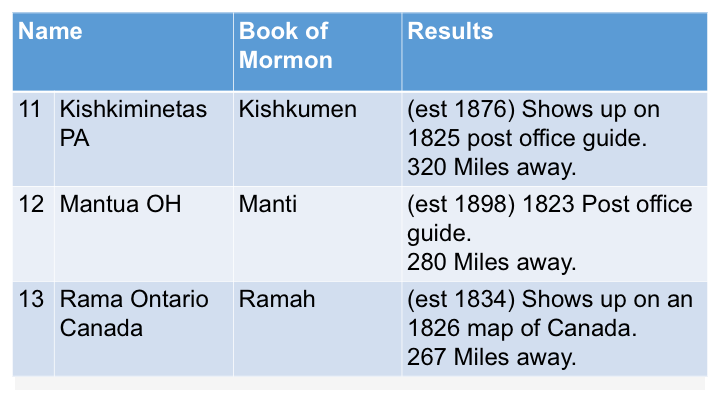
The other 4 names here are equally as unlikely with them being a long distance away, and not being incorporated towns. But they did show up on a post office guide as a post stop. That’s why, as unlikely as they are, I put them into the “Maybe” category.
The last 6 names on the next two slides could be claimed to be hits because they were in existence. With some of them proximity may still be an issue.
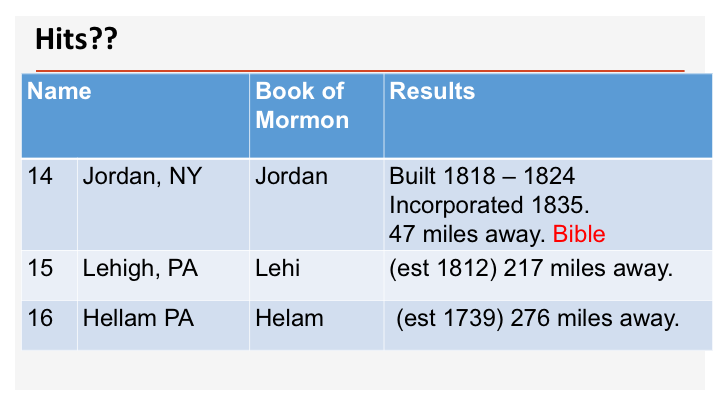
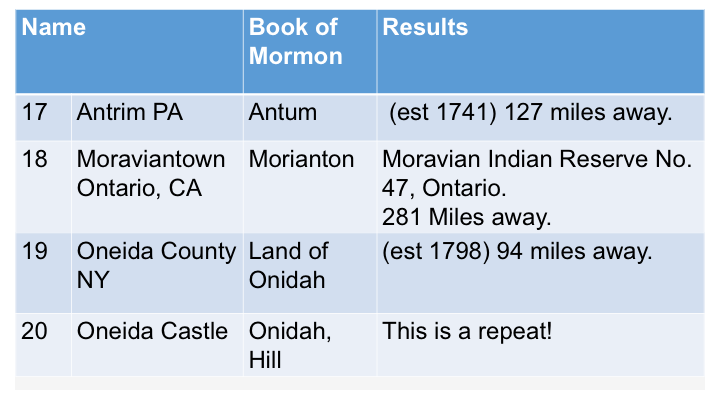
Why do I say 6 when 7 names are listed here? Because the last name is simply a repeat of name number 6. Of those 6 names, the Bible is likely a better source for the name Jordan, so we should take that one off the list.
So, this whole map theory of Joseph-copying-local-names argument isn’t very strong with only about 5 names. And that is only if you believe things like Antrim is the source of the name Antum and Moraviantown, Ontario, CA is the source for the name Morianton.
Even if we decide to include the unlikely locations from our “maybe” list like Ripple lake, after we take out the clear Bible references, the most we can get is 10 names. That leaves only 76 Book of Mormon names to go!
The CES Letter gives us a possible source of two more of those names from 8000 miles away and tells us how Joseph Smith learned those names.
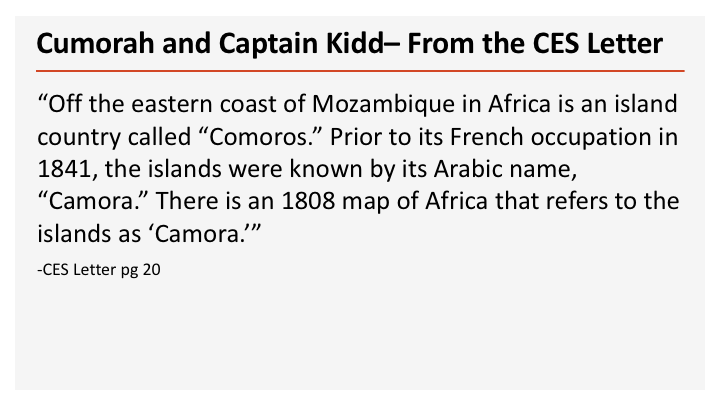
Quoting from the CES letter:
Off the eastern coast of Mozambique in Africa is an island country called “Comoros.” Prior to its French occupation in 1841, the islands were known by its Arabic name, “Camora.” There is an 1808 map of Africa that refers to the islands as “Camora.”[14]
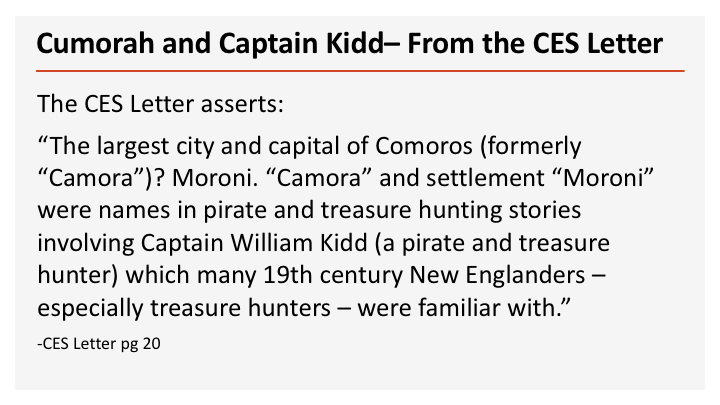 The CES letter goes on to assert:
The CES letter goes on to assert:
The largest city and capital of Comoros (formerly “Camora”)? Moroni. “Camora” and settlement “Moroni” were names in pirate and treasure hunting stories involving Captain William Kidd (a pirate and treasure hunter) which many 19th century New Englanders – especially treasure hunters – were familiar with.[15]
There are problems with this statement, the first being that Moroni did not become the capital of Camora until 1876. It was at most a tiny village that wasn’t even mentioned on any contemporary Gazetteers, or map indexes, I could find. But for the sake of discussion we will accept the general premise and move on.
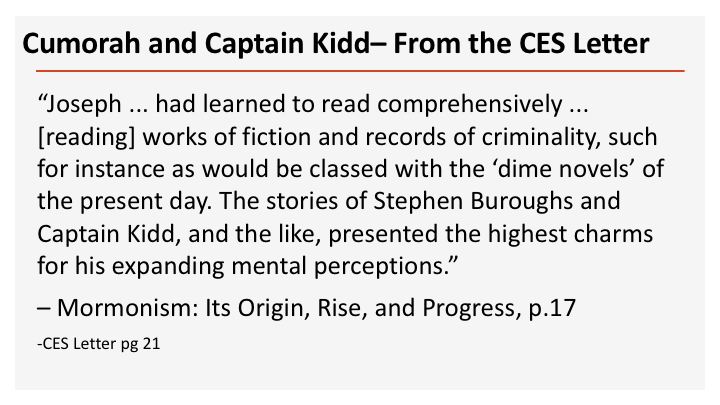
What does this have to do with Joseph Smith? The CES Letter quotes from Pomroy Tucker in a book critical of Mormonism written in 1867, 23 years after the death of Joseph Smith.
Joseph … had learned to read comprehensively … [reading] works of fiction and records of criminality, such for instance as would be classed with the ‘dime novels’ of the present day. The stories of Stephen Buroughs and Captain Kidd, and the like, presented the highest charms for his expanding mental perceptions.
– Mormonism: Its Origin, Rise, and Progress, p.17[16]
Well, that quote pretty much contradicts what everyone that knew Joseph Smith said about him. Even his own mother said he didn’t read much. But, let’s go with it. Let me try to summarize the argument.
- Comorah and Moroni are Arabic names from an Island near Mozambique.
- These names were repeated in stories involving Captain William Kid.
- A lot of people in the area read Captain Kidd stories.
- In fact, Pomeroy Tucker remembers 40 or 50 years later that Joseph Smith read these stories as a boy.
- Therefore, that is where Joseph Smith got the names Cumorah and Moroni for the Book of Mormon.
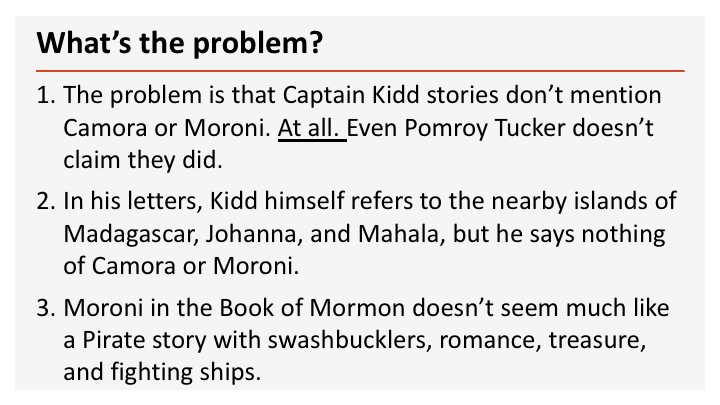
The problem is that Captain Kidd stories don’t mention Camora or Moroni. At all. Even Pomeroy Tucker doesn’t claim they did. If there IS a reference I’ve missed, it means Joseph Smith managed to find something that a 21st century researcher with Google couldn’t find. For those really interested, Comoros is mentioned in literature in 1844, 1863, 1864 and 1885. But that wouldn’t be relevant as that was all after the martyrdom of Joseph Smith.
In his letters, Kidd himself refers to the nearby islands of Madagascar, Johanna, and Mahala, but he says nothing of Camora or Moroni.
And Moroni in the Book of Mormon doesn’t seem much like a Pirate story with swashbucklers, romance, treasure, and fighting ships.
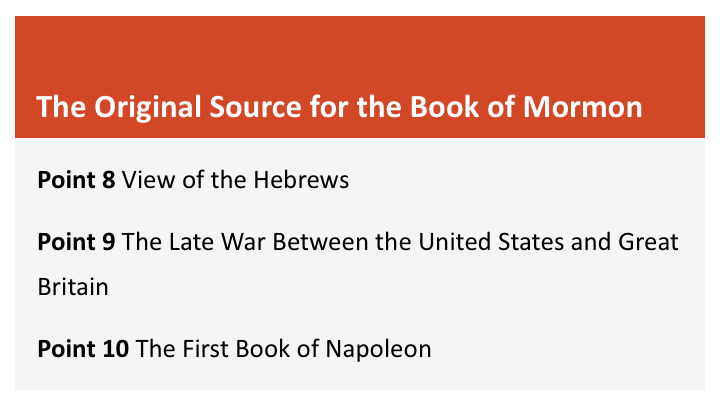
This takes us to the next three claims, the original source for the Book of Mormon. One of the arguments made is that the Book of Mormon was cribbed, stolen, or plagiarized from another book. These arguments are popular because the people who knew Joseph Smith also believed that there was no way he could have written the Book of Mormon.
The first problem with this argument, is that 3 different books are given for the source of the Book of Mormon. To me, that says that no argument for any of these is particularly compelling. And as we get into detail, you will understand why.
Let’s talk about The View of the Hebrews.

Point 8 “There was a book published in 1823 Vermont entitled View of the Hebrews.”[17] It contains around 57,000 words. In contrast, the Book of Mormon contains 268,163 words.
But the Letter to a CES director fills 3 and a half pages of parallels showing how similar the books are.
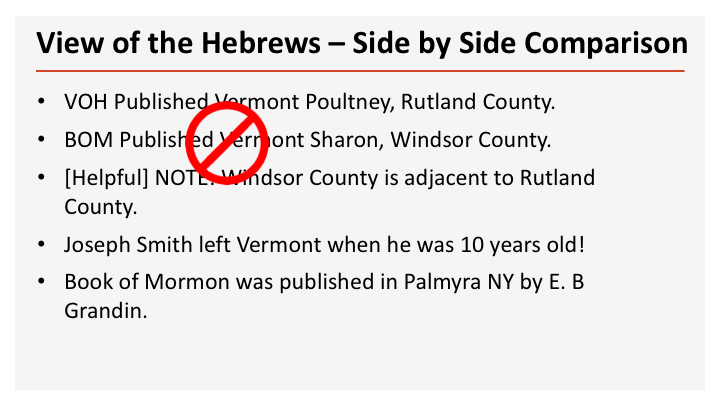
It starts with the location of the publication, Vermont Poultney, Rutland County. [18] Then it gives the Location for the Book of Mormon publication of Vermont Sharon, Windsor County. [19] Then we are given a really helpful note tying the books together that says: NOTE: Windsor County is adjacent to Rutland County.[20] This could be the smoking gun. Published in a neighboring county!
But, no.
Joseph Smith moved from Sharon, Vermont, when he was 10. The Book of Mormon was published in Palmyra, New York, by E. B. Grandin. You can visit the publishing house when you visit Palmyra. It is quite a tourist attraction
But, again – giving the benefit of the doubt, assuming an innocent mistake, lets move along to the list of parallels. Here are the first 4 listed.
Both books talk about:
- The destruction of Jerusalem √ √
- The scattering of Israel √ √
- The restoration of the Ten Tribes √ √
- Hebrews leave the Old World for the New World √ √
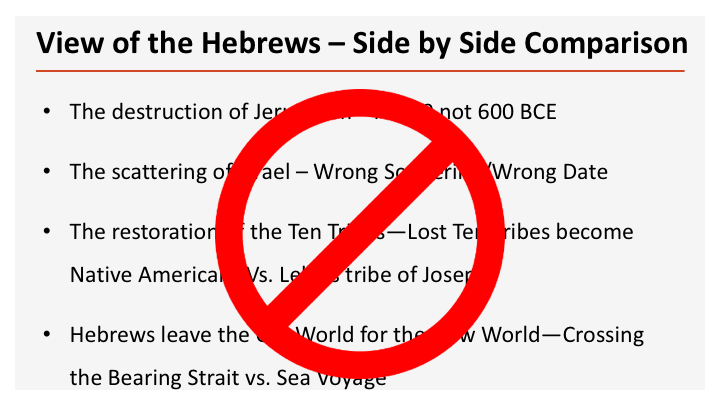
The View of the Hebrews begins with a discussion of the destruction of Jerusalem in 70 AD. Then it goes on to describe the evils of all the Romans leaders.
The Book of Mormon talks about the destruction of Jerusalem at the time of the Babylonians in 600 BC when the Israelites were captured and says nothing about Romans.
The view of the Hebrews talks about the 10 lost tribes crossing over to America via the Bering Strait and being restored here as Native Americans, and the Book of Mormon talks about a boat and doesn’t really get into the 10 lost tribes that much.
There just isn’t a match.
Going down the entire list point by point you will find:
- The books aren’t even remotely alike except in the most superficial manner.
- There is no story line in View of the Hebrews.
- There are no prophets in the View of the Hebrews, as Ethan Smith – a devout Protestant – didn’t believe in non-Biblical prophets.
- There is no new scripture in the View of the Hebrews, as Ethan Smith believed the Bible to be a closed canon.
- The books have a completely different purpose. This book appears to be historical commentary while the Book of Mormon is inviting us to come unto Christ.
Most of the early Saints learned about this book when Joseph Smith himself quoted from the book in 1842 in the Church newspaper, the Times and Seasons. If he had plagiarized from that book, I doubt he would try to bring it to everyone’s attention. This would be, in the words of one reviewer, the Joseph Smith was a brilliant con man AND a blithering idiot theory.
You can find View of the Hebrews online with a simple Google search. I invite you all to read it. The CES Letter author seems to be hoping that you won’t. Because once you do, you will immediately recognize how nonsensical this claim is.
Which brings us to Point 9.
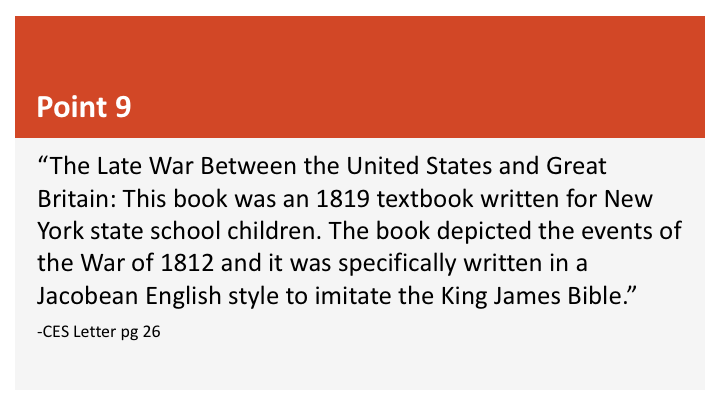
From the CES Letter we read, “The Late War Between the United States and Great Britain: This book was an 1819 textbook written for New York state school children. The book depicted the events of the War of 1812 and it was specifically written in a Jacobean English style to imitate the King James Bible.“[21]
Where does the Book of Mormon Plagiarism claim come in? In October of 2013 two researchers presented at an ExMormon Foundation meeting in Salt Lake City that this book could be the source of the Book of Mormon. The researchers put the book into a computer and had the computer find parallel phrases between the two books. Much has been written on why this method doesn’t really work because Computers can’t read context. We see this in the 75 parallels that came from the copyright page alone! But, let’s look at it anyway.
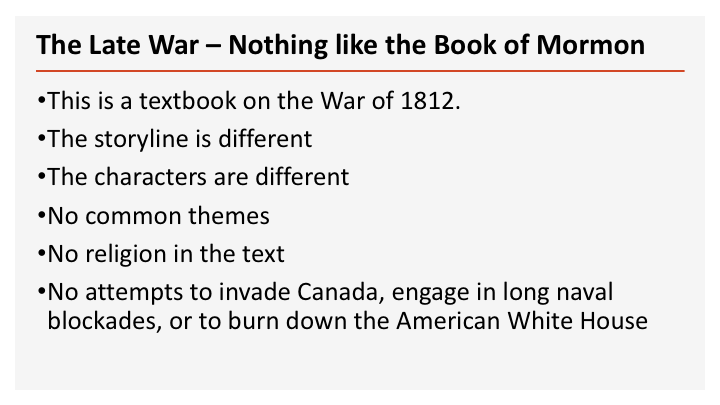
First of all, the Late War is NOTHING like the Book of Mormon
- This is a textbook on the War of 1812.
- The storyline is different.
- The characters are different.
- There are no common themes.
- There is no religion in the text.
- And in the Book of Mormon, I don’t read about any attempts to invade Canada, engage in long naval blockades, or to burn down the American White House.
But the book gives us a list of parallels. To give you a flavor of those parallels, let me give two examples.
Objects made “partly of brass and partly of iron, and were cunningly contrived with curious works, like unto a clock; and as it were a large ball.”[22]
- Is it the Liahona?
- No it’s a Torpedo!
How about the “rod of iron”?
- Is it to guide us to the tree of life?
- No it’s a weapon. It says “Then will we rule them with a rod of iron.”
The rest of the so-called parallels are equally as bad, although I will admit that both books mention elephants and boats.
But, using a Google search for elephants and boats, the book “The Life of Horatio Lord Viscount Nelson and his Glorious Achievements under the British Flag” also comes up. Yet so far, nobody brings that up as a possible source of the Book of Mormon.
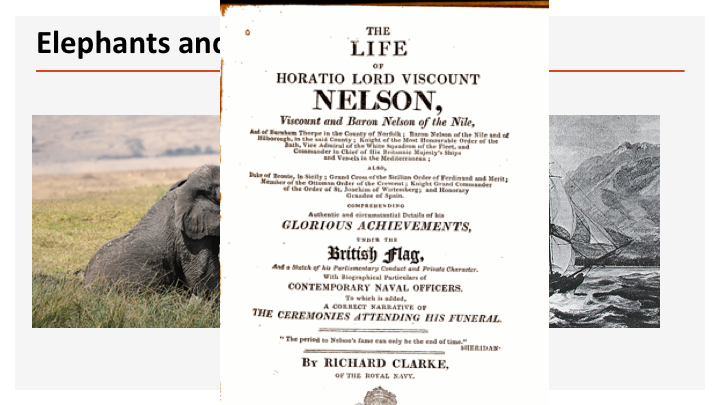
The author of the CES Letter seems to be hoping that you won’t read this book either. And of course, you won’t. Who has time? Also, we – as readers- generally trust what authors write in books. We trust that they have done the research for us. But, in this case, it would be a mistake to do so.
So, there is one more book that is brought up as a source. Let’s see if that one holds up better than the last two.
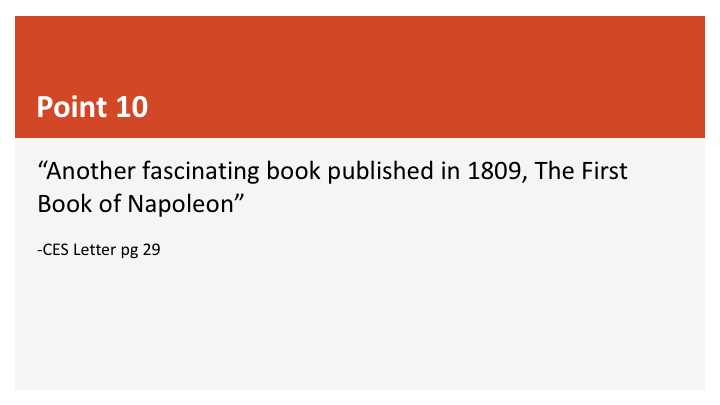
The CES letter says: “Another fascinating book published in 1809, The First Book of Napoleon”[23]
The following is a side-by-side comparison of selected phrases the Book of Mormon is known for from the beginning portion of the Book of Mormon with the same order in the beginning portion of The First Book of Napoleon (note: these are not direct paragraphs).[24]
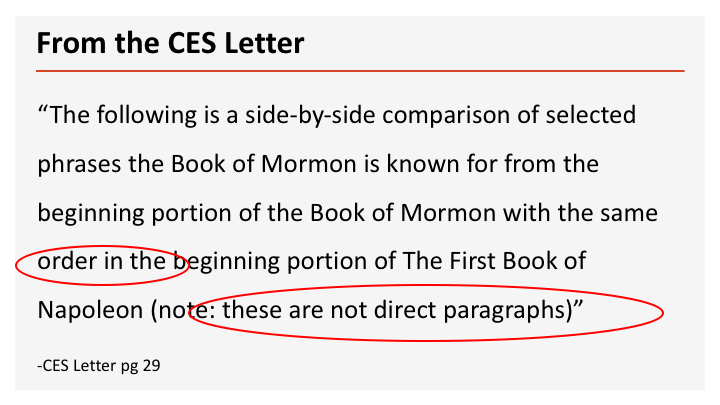
I look at these lines and think…Hmmm. That’s an odd thing to say. Why is he saying the same order, and these are not direct paragraphs?
Let’s take a look. Here is a paragraph given from the First Book of Napoleon:
Condemn not the (writing)…an account…the First Book of Napoleon…upon the face of the earth…it came to pass…the land…their inheritances…their gold and silver and…the commandments of the Lord…the foolish imaginations of their hearts…small in stature…Jerusalem…because of the perverse wickedness of the people.[25]
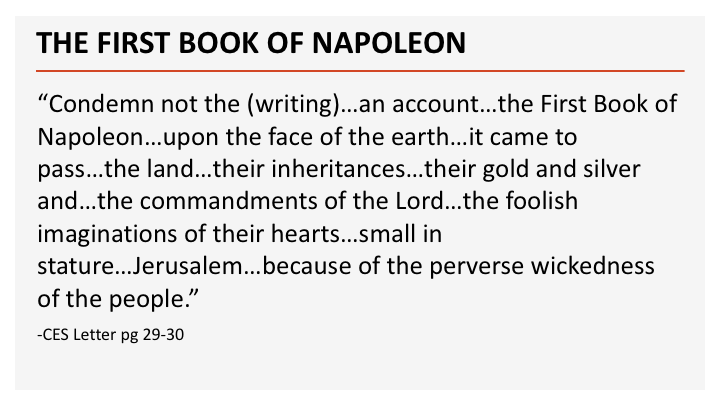
Here is the paragraph given from the Book of Mormon:
Condemn not the (writing)…an account…the First Book of Nephi…upon the face of the earth…it came to pass…the land…his inheritance and his gold and his silver and…the commandments of the Lord…the foolish imaginations of his heart…large in stature…Jerusalem…because of the wickedness of the people.[26]
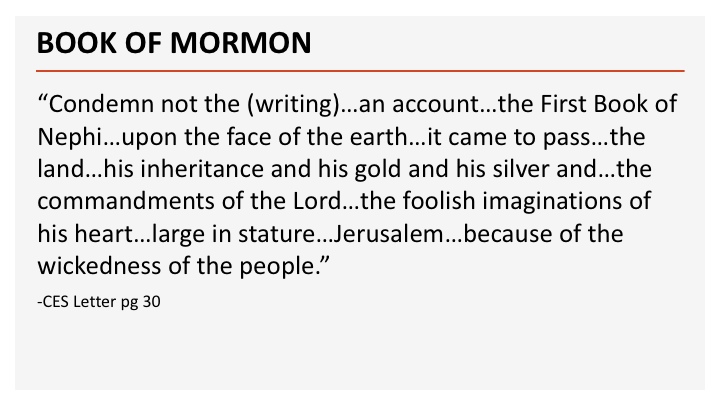
Well, the first problem is with the Book of Mormon quote and the word “writing.” This phrase comes from the title page where it says wherefore, condemn not the things of God.
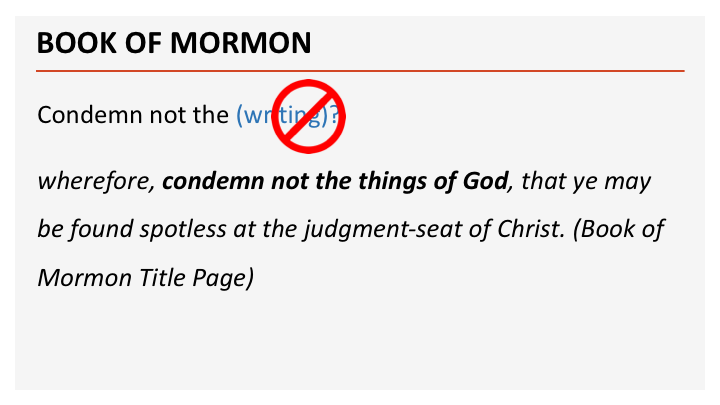
It has nothing to do with writing.
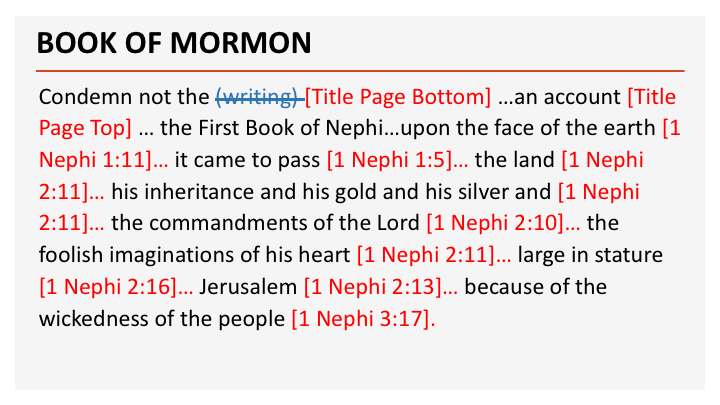
To continue the paragraph you have to go back to the top of the page to pick up the words “an account” then skip down to 1 Nephi 1:11 for the next phrase and then turn BACK to 1 Nephi 1:5 for the next one, and then skip forward to 1 Nephi 2:11 for the next phrase. And on it goes. Cherry picking a few words here and a few words there. It takes 3 chapters plus the Title page to construct this false paragraph.

And what about the paragraph from the First Book of Napoleon. It takes 25 pages to create that paragraph. Those red dots are where the words came from.
No wonder that the author of the CES letter said Quote “these are not direct paragraphs” because even he seemingly felt uncomfortable with it. And he is wrong about the phrase “with the same order.” They are not all in the same order.
Can anyone really believe that Joseph Smith Copied from the First Book of Napoleon to create the Book of Mormon? If it was such an obvious copy, one has to ask why someone felt the need to painstakingly create these two fictitious paragraphs.
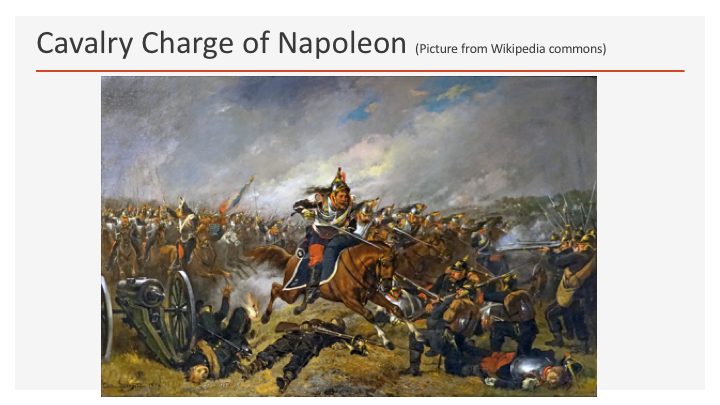
The reality is that here again these two books have nothing in common. Where is the great French cavalry charge in the Book of Mormon? And where is the testimony of Christ in the First Book of Napoleon?
The First Book of Napoleon, the Late War, the View of the Hebrews – None of these have anything to do with what is written in the Book of Mormon. So why would they be in the CES Letter with descriptor words such as “Stunning”, “fascinating,” “I was floored” and “how phenomenally unlikely it is that so many common rare phrases and themes could be found between these books”?
I will let you decide.
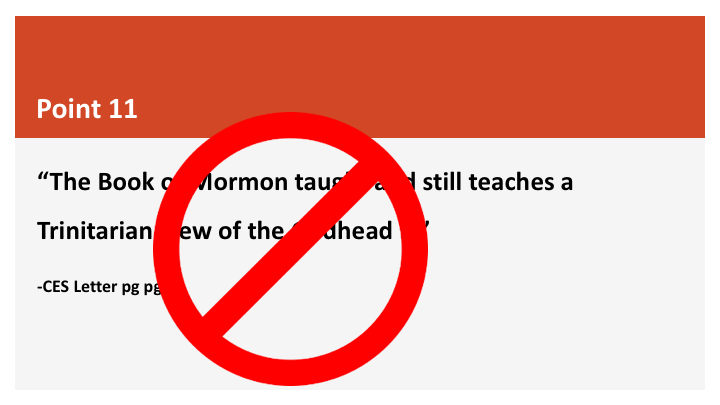
There is one more claim in chapter 1 of the CES letter, which says, “The Book of Mormon taught and still teaches a Trinitarian view of the Godhead …”
My response is, no, it doesn’t.
We know as members of the Church of Jesus Christ of Latter-day Saints that to get a full understanding of a topic, we should read all the various related verses.

For example, if you look at Alma 11:44, or 3 Nephi 28:10 and 11, the passages clearly identify the Father, Son and Holy Ghost as distinct beings, but remind us that they are one in purpose and one God. It is a consistent teaching of Joseph Smith and the Church.
So, let’s review the 11 claims.
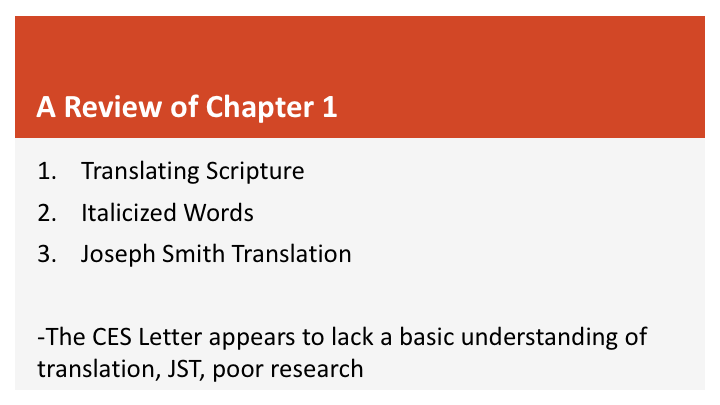
In points 1,2 & 3 we covered: translating scripture, italicized words, and the Joseph Smith Translation. The CES letter appears to show a lack of understanding of translating between languages, of what the Joseph Smith translation is, and a pattern of poor or misleading research, used to promote his narrative.

In points 4, 5, and 6 the letter covers DNA, Anachronisms and Archeology. In these three points, the pattern of unsubstantiated or poorly researched claims continues.
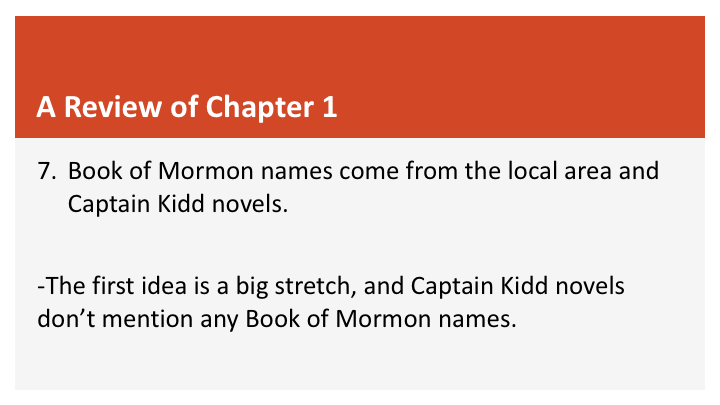
Point 7 is that Book of Mormon names come from the local area and Captain Kidd novels. This idea is a big stretch and, additionally, Captain Kidd novels didn’t mention any Book of Mormon names.
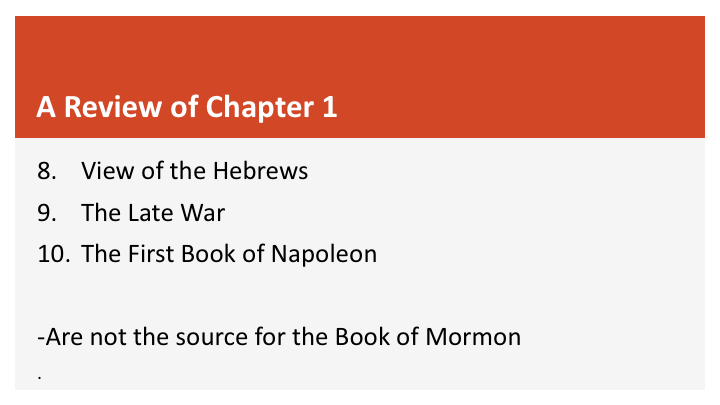
Point 8, 9, and 10. The View of the Hebrews, the Late War, and the Book of Napoleon are clearly not the source of the Book of Mormon and
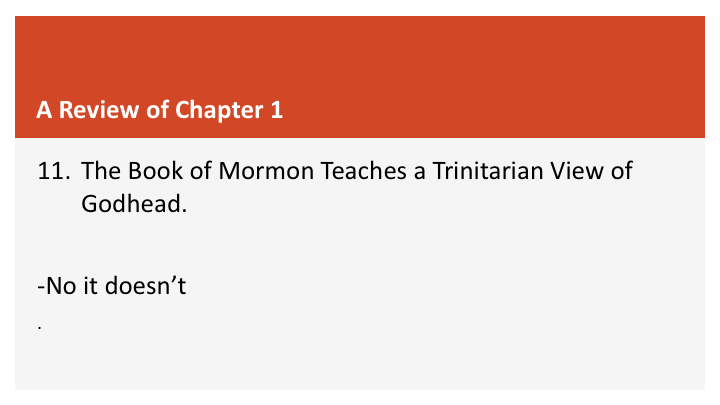
Finally, Point 11: the Book of Mormon teaches a trinitarian view of the Godhead. My response is, if you believe that, you are in the minority. The general membership of the Church, the church leadership, as well as all the Christian churches that attack us for being non-trinitarian certainly don’t believe the Book of Mormon teaches that.
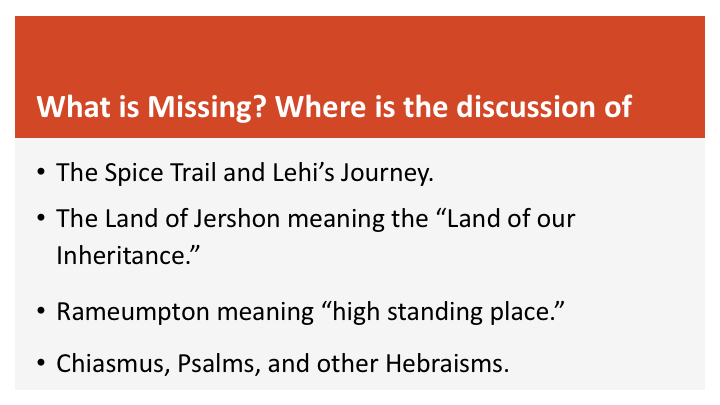
What is left out from the discussion in the CES letter are all of the internal evidences, plus the external discoveries that support it as an ancient document such as:
- The ancient Spice Trail that matches the travels of Lehi in the old world
- The Land of Jershon meaning the Land of our Inheritance
- Rameumpton meaning high standing places
- Evidence of Chiasmus, Psalms, and other Hebraisms throughout the Book of Mormon, particularly in 2 Nephi chapter 4 and Alma 36.
I can go on and on. If you don’t know about these things, you can find them on the FairMormon Website, and many other Websites such as Book of Mormon Central and Interpreter.
Going back to my initial question: Is the CES letter proof or propaganda?
Based on the first chapter alone, I believe the “proof” claim is weak at best. His pattern of poorly supported research and misleading facts used in these first eleven points make me skeptical about his claims in the remainder of the book. Given his track record, no claim can be taken at face value. Each must be investigated individually and thoroughly.

There is a quote on the back cover of the CES Letter from President J. Reuben Clark which says, “If we have the truth, no harm can come from investigation. If we have not the truth, it ought to be harmed.” I know this was meant to be talking about the Church of Jesus Christ of Latter-day Saints. But we have just spent time investigating the points from the first chapter of the CES letter, and the claim of truth in that chapter cannot be supported.
If this is the best that can be given, it reinforces my testimony of the Book of Mormon. I am grateful to be a member of the Church of Jesus Christ of Latter-day Saints. I appreciate that I can not only receive a spiritual witness of the Book of Mormon, but that this sacred book can also withstand intellectual criticisms.
Thank you.
[1] “Anti-Mormon spam email targets LDS Business College students,” Salt Lake Tribune (Apr 30, 2014)
[2] CES Letter pg 14
[3] https://cesletter.org/1769-kjv-errors/
[4] CES Letter pg 14
[5] CES Letter pg 15
[6] https://www.churchofjesuschrist.org/study/ensign/1997/08/the-joseph-smith-translation-plain-and-precious-things-restored?lang=eng
[7] https://www.churchofjesuschrist.org/study/history/topics/joseph-smith-translation-of-the-bible?lang=eng
[8] CES Letter pg 15
[9] CES Letter pg 15
[10] http://centerplace.org/hs/iv/iv-mat.htm
[11] CES Letter pg 18
[12] CES Letter pg 18
[13] https://cesletter.org/debunking-fairmormon/book-of-mormon.html#8
[14]CES Letter pg 20
[15] CES Letter pg 20
[16] CES Letter pg 21
[17] CES Letter pg 21
[18] CES Letter pg 22
[19] ibid
[20] ibid
[21] CES Letter pg 26
[22] CES Letter pg 27
[23] CES Letter pg 29
[24] ibid
[25] CES Letter pg 29-30
[26] CES Letter pg 30
Audio and Video Copyright © 2019 The Foundation for Apologetic Information and Research, Inc. Any reproduction or transcription of this material without prior express written permission is prohibited.
